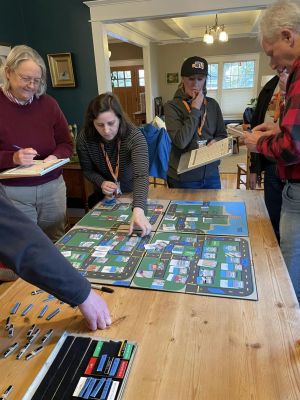2023-2024 NET Program Realignment
Hello! Jeremy Van Keuren here This page is composed in the first person so I can type and edit faster.
This page presents a proposal for realigning elements of PBEM's volunteer programming (which includes NETs, BEECN, and ATVs). The objectives of these changes would be to:
- Address the fall-off of meeting attendance at routine NET Team Meetings;
- Prepare PBEM volunteer programming to meet and weather through the many changes coming to the City of Portland's government structure and the structural changes taking place at PBEM;
- Ensure programming is structured logically to meet the challenges of both climate change/extreme weather events, and the threat of a Cascadia Subduction Zone earthquake;
- Encourage the growth and development of block-scale neighborhood teams.
Two other important notes about this proposal:
- The ideas here are reflected in what NETs are already doing and what NETs have asked PBEM to do;
- We're not attempting to take options away, but to add options for NETs to organize.
Summary
The notion of realignment is important for this proposal. There is no intention to radically restructure PBEM volunteer programming. Instead, the intention is to better coordinate disparate parts of what we have and assemble them into a program that opens more doors to participating, from full NET volunteers to untrained neighbors.
What is Driving Realignment?
I am proposing program realignments both in response to long-term, know issues in NET as well as some urgent realizations that have emerged:
Climate change
Since NET's founding in 1994, the threat of a Cascadia Subduction Zone earthquake provided the urgency behind disaster preparedness and response programming. That threat remains. But a new fighter has entered the ring: extreme weather events caused by climate change. Extreme weather, such as heat domes and snow storms, have (and will continue to) take lives and result directly in more NET volunteers deployed for more hours.
In the immediate post-COVID era, January 2022 to October 2023, NETs logged approximately 3,917 deployment hours. That includes planned deployments, such as serving as parade guides and first aid response at the Rose Festival or fire fuel mitigation. 61% of those deployment hours were logged in response to events caused by extreme weather. When I started at PBEM in 2012, that percentage was closer to 10%. And the percent attributable to extreme weather events is likely only to climb.
Organizational changes
The City of Portland is undergoing the most radical restructuring of its government in its history. Day 1 of the new government is January 1, 2025. But, organizational transformations and fluctuations will continue well beyond that date as city government settles into its new state of being. This is relevant to us as NET volunteers as all programs are more carefully scrutinized and evaluated. NET should be ready for that scrutiny and seen as one of the strongest community programs in the City (and not just as a specialized emergency response program). We show that strength by demonstrating our connections to our neighborhoods, as opposed to being a program of insular disaster responders.
As the City government changes, PBEM is simultaneously changing. We're undertaking an important reconstruction of our Operations Section. As NET volunteers have worked hard to grow the credibility of the NET program, it has become an increasingly important part of our routine emergency management response structure. For example, NET volunteers are called into the ECC/EOC to help when we have an activation. I am not aware of another CERT program that can say that.
Any organizational restructuring should imply a restructuring of resources as well. Though nothing is set in stone, we should prepare ourselves to have less access to resources in the immediate future, and also prop up the Friends of Portland NET for fundraising more if, for no other reason, than a fiscal safety mechanism. However, few teams are cozy enough with their neighbors to fundraise for their teams, and PBEM/NET needs to encourage a higher level of direct engagement with neighbors at the block-scale level.
Revisiting the purpose of a NET team
Among the most significant change drivers, however, is a simple epiphany or two about NET and why they meet as teams.
1.) Centralized deployments and self deployments
In its history, NETs have never self deployed. To review: a NET self deployment is OK'd by PBEM when two key conditions are met: 1.) a citywide disaster is taking place; and 2.) regular communication systems are not functional. When those conditions are met, the expectation is that NETs check themselves/family/immediate neighbors to make sure they're OK. If so, they deploy to their staging areas and commence their Team Operations Plans.
Only an earthquake, therefore, would ever prompt NETs to self deploy.[1] All other NET deployments have always been, and envisioned ever as, centralized through PBEM. In other words, when there is an emergency, PBEM decides:
- Whether to deploy volunteers
- Where they will deploy from or to
- What responsibilities volunteers will take on
- When the response period(s) will be
- How volunteers will be kept reasonably safe
In a self deployment, NETs propose answers to all of the above in their Operations Plans. But if NETs only self deploy for an earthquake, Operations Plans are, in fact, earthquake response plans.
So: one reason NETs meet as a team is to plan their earthquake response and forward their Operations Plans earthquake response plans to PBEM.
2.) Training and socializing

But earthquake response planning is not the only reason we've heard from teams that they organize and meet with each other. They also meet to:
- Train together. This is done on different scales...everywhere from tabletop exercises to full blown comprehensive search and rescue at Scenario Village. Training together as a team is important because team members should build relationships and working routines before they need to work together in an intense response situation.
- Socialize. The basic act of gathering as a team, even if for no other purpose than to get to know one another, is the most important part of community resilience. The number one best thing you can do to prepare for a disaster is get to know your neighbors.[2] PBEM staff have also heard consistently from NETs that they want to connect more with the community on their street/floor/block level, but they don't feel entirely sure how to do that or how to keep those non-NET neighbors engaged.
If we accept that the primary reasons for meeting as a team are earthquake response planning and training/socializing, then we should structure NET to facilitate those activities.
A few of the NET program's known issues
I believe that some of the NET program's "known issues" are caused by a misalignment in what we're doing, and/or I believe a realignment can resolve those issues. Those include:
- NET meeting attendance is low. Ever since the COVID pandemic, NET leaders report low meeting attendance at regular meetings. At the same time, a few exceptions aside, NET volunteers fill the deployment requests that PBEM makes. This leads me to conclude that low meeting attendance is not due to volunteers not feeling engaged. I admit that I'm not entirely sure the reason for the drop off in meetings. Anecdotes and my own educated guesswork[3] suggests it is because teams lack a mission and arc...a clear path that goes from "a group of loosely associated people who live in the same large geographic area" to "a prepared and knowledgeable team of confident volunteer disaster responders".
- Operations Plans are good but need to develop. PBEM began asking teams for Ops Plans in 2013. Since then, we've received some really good ones. But they need to move to the next stage. First, there is no template for Operations Plans and one is needed: both to bring clarity to NET volunteers, and to better apprise PBEM of team capabilities and to help PBEM staff know what NETs will be doing when self-deployed. Second, I believe all Ops Plans received by PBEM have only included trained NET volunteers. They should be inclusive of neighbors and ATVs as well; it is a glaring and troublesome omission.
- Team Service Area boundaries are not logical. For over 20 years, teams have organized by neighborhood association boundaries. But if we decide that a team's response area is for earthquake response, we cannot expect even a well organized and highly trained group of NETs to take on the area encompassed by even a small neighborhood association. The average Portland neighborhood is 2.5 square miles and has 16,000 people living in it.
- NETs want to engage with the neighbors who live around them. Related to the Service Area issue, Glenn and I hear consistently from NETs that they really want to help get their immediate neighborhoods prepared. That is, the level of the block, the street, or (in the case of apartment/condo buildings) the floor. But PBEM has not provided clear and engaging paths to doing that.
Notes and References
- ↑ ...or an electromagnetic pulse (EMP). But in this stage of the conversation, I don't think it's particularly helpful to explore the horrifying implications of that. https://www.economist.com/the-world-if/2017/07/13/the-disaster-that-could-follow-from-a-flash-in-the-sky
- ↑ A few good sources on that, if you're interested: | Recovering from disasters: Social networks matter more than bottled water and batteries | The Key To Disaster Survival? Friends And Neighbors | Why knowing your neighbors could save you in the next climate disaster | As Disasters Worsen, Cities and Researchers Eye Social Resilience | Column: Even in a flood, government can’t save us. Disaster response must be people-powered | Locals are first responders during disasters but they are ill-equipped and untrained
- ↑ One of the survey questions I will be asking, though, is "If you haven't been to a NET meeting lately, why?"
